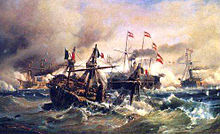Emilio Faà di Bruno
He served under Admiral Giuseppe Albini aboard the corvette Malfatano and the frigate San Michele in the Adriatic, during the search for the Austrian fleet between the mouths of the rivers Piave and Tagliamento and in the blockade of Trieste.
During the Second Italian War of Independence, he distinguished himself at the Siege of Gaeta (1860) and won the knight's cross (croce di cavaliere) of the Order of Saints Maurice and Lazarus.
[1] In 1865, Faà di Bruno was given command of the steam corvette Castelfidardo and began working with Admiral Giovanni Vacca in developing the navy into a world-class force.
The majority of historians are more inclined to accept the story of Commander Andrea del Santo, the deputy chief of staff to Persano, who recalled that Faà di Bruno jumped into the sea but was dragged under by the sinking ship.
Although the greatest blame for the loss at Lissa falls on Persano, it was Faà di Bruno who decided, upon sighting an enemy bow, to reverse course, losing headway and being caught almost at a standstill by the ramming Ferdinand Max.
[1] On 15 August 1867, the Italian government awarded Faà di Bruno a Gold Medal of Military Valour, with the citation: "For his conduct in the naval operations at Lissa on the days of 18, 19 and 20 July 1866".

